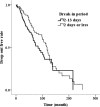Early technical complications and long-term survival of urgent peritoneal dialysis according to break-in periods
- PMID: 30365566
- PMCID: PMC6203382
- DOI: 10.1371/journal.pone.0206426
Early technical complications and long-term survival of urgent peritoneal dialysis according to break-in periods
Abstract
Background: Guidelines recommend a break-in period of 2 weeks before starting peritoneal dialysis (PD), but PD within 14 days is also an acceptable and safe alternative to hemodialysis (HD) in patients with an urgent need. However, the effect of the break-in period within 48 hours or later had not been evaluated for early technical complications, long-term maintenance, and survival in patients starting urgent PD.
Methods: Of 360 patients with a surgically inserted PD catheter, we evaluated 190 patients who needed urgent PD and 29 patients who received conventional PD at a single center between January 2007 and December 2014 in this retrospective observational study. Enrolled patients were divided according to break-in period of <48 hours (P1) or 2-13 days (P2) before starting urgent PD. The primary endpoint was incidence of early technical complications and secondary endpoints included long-term PD maintenance, and patient survival.
Results: PD was started in 103 patients (54.2%) within 48 hours and in 87 patients (45.8%) within 2 to 13 days. The incidence of early technical complication was significantly higher in P1 group (28.2%) than in P2 group (10.3%) (P = 0.002). The need for a repositioning procedure was significantly greater in P1 group (14.6%) than in P2 group (3.4%) (P = 0.009). However, we observed no significant differences between the two groups with respect to the prevalence of catheter dysfunction requiring change to HD within 6 months or incidence of peritonitis or exit-site infection. There was no significant difference in PD maintenance and patient survival according to the break-in period between P1 and P2 as well as against the control group.
Conclusion: Urgent PD was associated with a low incidence of early technical complications if start was avoided within 48 hours after catheter insertion, and long-term PD maintenance was independent of the break-in period.
Conflict of interest statement
The authors have declared that no competing interests exist.
Figures
Similar articles
-
Urgent-start peritoneal dialysis versus conventional-start peritoneal dialysis for people with chronic kidney disease.Cochrane Database Syst Rev. 2020 Dec 15;12(12):CD012913. doi: 10.1002/14651858.CD012913.pub2. Cochrane Database Syst Rev. 2020. PMID: 33320346 Free PMC article.
-
Urgent-Start Peritoneal Dialysis and Hemodialysis in ESRD Patients: Complications and Outcomes.PLoS One. 2016 Nov 8;11(11):e0166181. doi: 10.1371/journal.pone.0166181. eCollection 2016. PLoS One. 2016. PMID: 27824950 Free PMC article.
-
Feasibility of Urgent-Start Peritoneal Dialysis in Older Patients with End-Stage Renal Disease: A Single-Center Experience.Perit Dial Int. 2018 Mar-Apr;38(2):125-130. doi: 10.3747/pdi.2017.00002. Epub 2017 Nov 21. Perit Dial Int. 2018. PMID: 29162677
-
Success of Urgent-Start Peritoneal Dialysis in a Large Canadian Renal Program.Perit Dial Int. 2016 Mar-Apr;36(2):171-6. doi: 10.3747/pdi.2014.00148. Epub 2015 Sep 15. Perit Dial Int. 2016. PMID: 26374834 Free PMC article.
-
Urgent-start peritoneal dialysis versus haemodialysis for people with chronic kidney disease.Cochrane Database Syst Rev. 2021 Jan 27;1(1):CD012899. doi: 10.1002/14651858.CD012899.pub2. Cochrane Database Syst Rev. 2021. PMID: 33501650 Free PMC article.
Cited by
-
Factors Associated With Urgent-Start Peritoneal Dialysis Catheter Complications in ESRD.Kidney Int Rep. 2020 Jul 26;5(10):1722-1728. doi: 10.1016/j.ekir.2020.07.025. eCollection 2020 Oct. Kidney Int Rep. 2020. PMID: 33102964 Free PMC article.
-
Percutaneous Insertion of Peritoneal Dialysis Catheters.Cardiovasc Intervent Radiol. 2025 Jan;48(1):6-15. doi: 10.1007/s00270-024-03873-z. Epub 2024 Oct 7. Cardiovasc Intervent Radiol. 2025. PMID: 39375238 Review.
-
Break-in Period ≤24 Hours as an Option for Urgent-start Peritoneal Dialysis in Patients With Diabetes.Front Endocrinol (Lausanne). 2022 Jul 14;13:936573. doi: 10.3389/fendo.2022.936573. eCollection 2022. Front Endocrinol (Lausanne). 2022. PMID: 35909563 Free PMC article.
-
Urgent-start peritoneal dialysis versus conventional-start peritoneal dialysis for people with chronic kidney disease.Cochrane Database Syst Rev. 2020 Dec 15;12(12):CD012913. doi: 10.1002/14651858.CD012913.pub2. Cochrane Database Syst Rev. 2020. PMID: 33320346 Free PMC article.
-
Prognosis of urgent initiation of peritoneal dialysis: a systematic review and meta-analysis.Ren Fail. 2024 Jan 30;46(1):2312533. doi: 10.1080/0886022X.2024.2312533. Epub 2024 Feb 23. Ren Fail. 2024. PMID: 38391179 Free PMC article.
References
-
- Heaf JG, Lokkegaard H, Madsen M. Initial survival advantage of peritoneal dialysis relative to haemodialysis. Nephrology, dialysis, transplantation: official publication of the European Dialysis and Transplant Association—European Renal Association. 2002;17(1):112–7. - PubMed
-
- Banli O, Altun H, Oztemel A. Early start of CAPD with the Seldinger technique. Perit Dial Int. 2005;25(6):556–9. - PubMed
Publication types
MeSH terms
LinkOut - more resources
Full Text Sources



